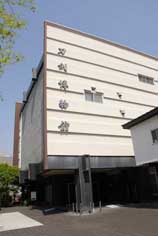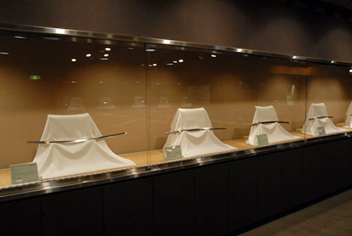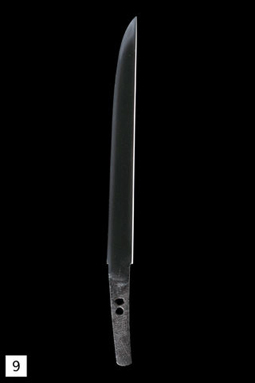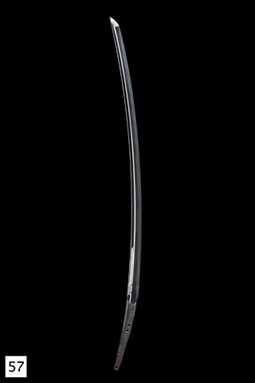 |
Focus features two in-depth reviews each month of fine art, architecture and design exhibitions and events at art museums, galleries and alternative spaces around Japan. The contributors are non-Japanese art critics living in Japan. |
|
|
 |
 |
 |
Powerful Aesthetics: The Japanese Sword Museum
Michael Pronko |
 |
 |
|
 |
|
| The museum in Shinjuku's back streets. |
|
Display cases allow the careful scrutiny of the details and the curves of the swords. |
Inside the meticulous display cases of the Japanese Sword Museum, swords appear less as arms than as art. Located in the back streets one stop west of Shinjuku Station, the museum offers six different exhibits a year of one of Japan's most precious and impressive cultural art forms -- the sword.
What greets the eye first in the main gallery is the long row of swords, some sharp-edge up and others sharp-edge down. The striking appearance of the blades, silver crescents arcing into the air, is stunning. Each sword has its own special shape, and the displays highlight that all-important curvature with great care.
The craftsmanship and design of each sword is aimed at finding the just-right proportions to make it not only an effective weapon, but also a piece of art. Even before scrutinizing the ornamentation, detail work and fittings, visitors can appreciate the time and effort spent on the pure shape of the steel.
The exhibit now on view until September 29 offers examples of the work of the first sword makers who came to Edo after the Tokugawa family moved the seat of the national government there. The many metalworkers and other artisans who set up shop in the shogun's capital made swords that were later classified as shintou or new swords. Numerous examples of the various types of weapons they produced -- the long katana, the wakizashi, the shorter tantou -- are on display.
After a period of fewer conflicts, and therefore less demand for swords, production flourished again in the mid-19th century. Works from this era have been designated shinshintou, or new-new swords. It is from this period that most of the swords in this exhibition were drawn. However, a few swords from as early as the 13th century are also on display. The museum's collection holds swords from as early as the Heian period, in the late 12th century.
 |
|
 |
|
|
|
| The shape of the sword was unique to each swordsmith, with a special design that contained special properties for both use and beauty. The designs in the early Edo period evolved for both practical and aesthetic reasons. |
|
Each sword needed its own customized scabbard to perfectly fit its shape and allow a smooth draw. The handle area at the bottom was inscribed with the name of the swordsmith. |
The current exhibition showcases the intricacy of the sword-making process. Especially intriguing are the mountings and fittings -- displayed, appropriately, as important works in themselves. The metalwork on sword guards, hilt ornaments, sheaths and other pieces, some so finely detailed that one almost needs a magnifying glass, drew lingering appreciation as visitors bent over the display cases to peer down at their rich artistry.
The smaller elements attest to the overall complexity of sword making. The efforts of scabbard makers, lacquerers, handle wrappers, soft-metal workers, and polishers, as well as the master swordsmiths themselves, all contribute to the final product. Fortunately, all those fittings are admirably preserved and beautifully presented by the Society for the Preservation of Japanese Art Swords that runs the museum. The exhibition also includes fittings from individual collectors.
The museum is clearly a labor of love for one of Japan's most defining cultural assets. For non-Japanese speakers, the museum has helpful explanations in English, which add considerably to one's appreciation and understanding of swords. The museum offers several different exhibitions of its vast collection every year, so it is well worth regular visits to see the new displays and to ponder how one of Japan's most characteristic weapons -- the sword -- has been turned into, not exactly a ploughshare, but an object of marvelous, contemplative beauty.
|
|
|
| The hand guards were of many different types depending on the owner's preference and could be changed. The patterns were often extremely elaborate. |
|
The ornaments on the hand grips and other attachments are often tied in place with complex patterns of silk wrapping that allow a better grip or simply add another element of artistic adornment to the sword.
All photos courtesy of the Japanese Sword Museum |
 |
 |
Michael Pronko
Michael Pronko teaches American literature, film, art and music at Meiji Gakuin University. He has appeared on NHK, Sekai Ichiban Uketai Jugyo, and other TV programs. His publications include several textbooks and three collections of essays about Tokyo. He writes regular columns for Newsweek Japan, ST Shukan, The Japan Times, and for his own websites, Jazz in Japan and Essays on English in Japan. |
|
 |
|